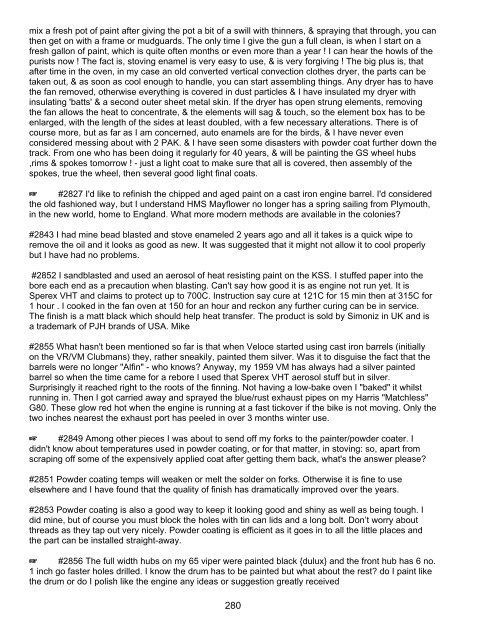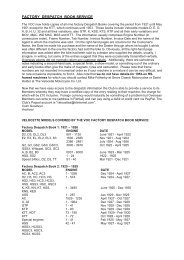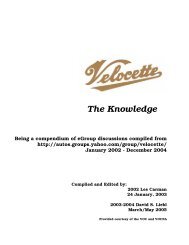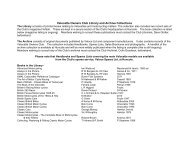The Knowledge - Velocette Owners Club
The Knowledge - Velocette Owners Club
The Knowledge - Velocette Owners Club
You also want an ePaper? Increase the reach of your titles
YUMPU automatically turns print PDFs into web optimized ePapers that Google loves.
mix a fresh pot of paint after giving the pot a bit of a swill with thinners, & spraying that through, you can<br />
then get on with a frame or mudguards. <strong>The</strong> only time I give the gun a full clean, is when I start on a<br />
fresh gallon of paint, which is quite often months or even more than a year ! I can hear the howls of the<br />
purists now ! <strong>The</strong> fact is, stoving enamel is very easy to use, & is very forgiving ! <strong>The</strong> big plus is, that<br />
after time in the oven, in my case an old converted vertical convection clothes dryer, the parts can be<br />
taken out, & as soon as cool enough to handle, you can start assembling things. Any dryer has to have<br />
the fan removed, otherwise everything is covered in dust particles & I have insulated my dryer with<br />
insulating 'batts' & a second outer sheet metal skin. If the dryer has open strung elements, removing<br />
the fan allows the heat to concentrate, & the elements will sag & touch, so the element box has to be<br />
enlarged, with the length of the sides at least doubled, with a few necessary alterations. <strong>The</strong>re is of<br />
course more, but as far as I am concerned, auto enamels are for the birds, & I have never even<br />
considered messing about with 2 PAK. & I have seen some disasters with powder coat further down the<br />
track. From one who has been doing it regularly for 40 years, & will be painting the GS wheel hubs<br />
,rims & spokes tomorrow ! - just a light coat to make sure that all is covered, then assembly of the<br />
spokes, true the wheel, then several good light final coats.<br />
L #2827 I'd like to refinish the chipped and aged paint on a cast iron engine barrel. I'd considered<br />
the old fashioned way, but I understand HMS Mayflower no longer has a spring sailing from Plymouth,<br />
in the new world, home to England. What more modern methods are available in the colonies?<br />
#2843 I had mine bead blasted and stove enameled 2 years ago and all it takes is a quick wipe to<br />
remove the oil and it looks as good as new. It was suggested that it might not allow it to cool properly<br />
but I have had no problems.<br />
#2852 I sandblasted and used an aerosol of heat resisting paint on the KSS. I stuffed paper into the<br />
bore each end as a precaution when blasting. Can't say how good it is as engine not run yet. It is<br />
Sperex VHT and claims to protect up to 700C. Instruction say cure at 121C for 15 min then at 315C for<br />
1 hour . I cooked in the fan oven at 150 for an hour and reckon any further curing can be in service.<br />
<strong>The</strong> finish is a matt black which should help heat transfer. <strong>The</strong> product is sold by Simoniz in UK and is<br />
a trademark of PJH brands of USA. Mike<br />
#2855 What hasn't been mentioned so far is that when Veloce started using cast iron barrels (initially<br />
on the VR/VM <strong>Club</strong>mans) they, rather sneakily, painted them silver. Was it to disguise the fact that the<br />
barrels were no longer "Alfin" - who knows? Anyway, my 1959 VM has always had a silver painted<br />
barrel so when the time came for a rebore I used that Sperex VHT aerosol stuff but in silver.<br />
Surprisingly it reached right to the roots of the finning. Not having a low-bake oven I "baked" it whilst<br />
running in. <strong>The</strong>n I got carried away and sprayed the blue/rust exhaust pipes on my Harris "Matchless"<br />
G80. <strong>The</strong>se glow red hot when the engine is running at a fast tickover if the bike is not moving. Only the<br />
two inches nearest the exhaust port has peeled in over 3 months winter use.<br />
L #2849 Among other pieces I was about to send off my forks to the painter/powder coater. I<br />
didn't know about temperatures used in powder coating, or for that matter, in stoving: so, apart from<br />
scraping off some of the expensively applied coat after getting them back, what's the answer please?<br />
#2851 Powder coating temps will weaken or melt the solder on forks. Otherwise it is fine to use<br />
elsewhere and I have found that the quality of finish has dramatically improved over the years.<br />
#2853 Powder coating is also a good way to keep it looking good and shiny as well as being tough. I<br />
did mine, but of course you must block the holes with tin can lids and a long bolt. Don’t worry about<br />
threads as they tap out very nicely. Powder coating is efficient as it goes in to all the little places and<br />
the part can be installed straight-away.<br />
L #2856 <strong>The</strong> full width hubs on my 65 viper were painted black {dulux} and the front hub has 6 no.<br />
1 inch go faster holes drilled. I know the drum has to be painted but what about the rest? do I paint like<br />
the drum or do I polish like the engine any ideas or suggestion greatly received<br />
280





